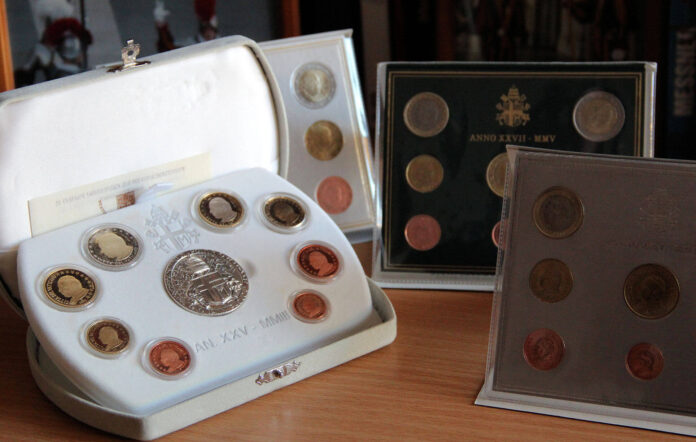Even if you don’t like to admit it: each and every one of us has already made a lousy numismatic deal and purchased an object at a ridiculously high price that was not worth it at all. The first principle of numismatics is: everybody learns to one’s cost, even those who don’t admit it! Therefore, you may comfort yourself. Blessed is he who has a thick skin, leans back, appears to be absolutely indifferent and still keeps his eagle eye on everything. Believe me, there are not many of those people; most collectors simply cannot wait. And I am one of them. Let’s be honest, we like to call ourselves passionate collectors who take joy in beautiful coins. We aren’t interested in the financial aspects or the potential increase in value of a certain coin – but yet, all of a sudden, we simply have to own a particular object. And it has to be right now! Well, just as in normal life, there is an angel and a devil in everybody.
The Object of the Collector’s Desire: Vatican Euro Coin Sets
In 2002, the Vatican had a flying start with euro coins: in addition to the other two small states Monaco and San Marino, the Vatican, too, announced that it would be issuing euro coin sets featuring the portrait of HH Pope John Paul II in the versions BU and proof (PR). Back then, some gazettes even spoke of a numismatic sensation and the prices obviously skyrocketed even before the sets were issued.
Those who bought the first Vatican euro coin sets for a lot of money on the secondary market back then are wiser today and perhaps their skin became a bit thicker thanks to this experience. If you want to thoroughly understand the situation, you need to have a close look at the state of affairs of 2002. One thing is for sure: long-time subscribers of collector coins of the Vatican had a huge advantage.
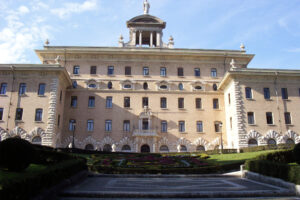
Subscribers Had a Huge Advantage in 2002
Let’s have a look at the news spread via collector’s magazines back then. There were reports on an incredibly long queue of hundreds of collectors in front of the issuing office of the Ufficio Filatelico e Numismatico (UFN). Other magazines knew immediately that (mainly) Italian speculators had bought all 65,000 BU coin sets in a way that didn’t appear to be 100% legal. And that was taken as a justification for the high prices that dealers demanded for these coin sets. There were even reports on turbulent scenes in front of the UFN office. Today we know, it was nothing but newspaper hoaxes and humbug.
Back then, the issuing office of coins and stamps of Vatican City was housed by the Governor’s Palace, behind St. Peter’s Basilica in the Vatican Gardens. However, it was not that simple to pass the Swiss Guard and the Gendarmerie Corps of Vatican City! That was and is absolutely impossible. Those who had already been subscribers of UFN coins for years automatically received the first euro coin set. The 2002 euro coin set (PR) in a card folder was sold at the price of €17. Therefore, subscribers were (and are still today) well-placed and paid the lowest price. The secondary market is always more expensive.
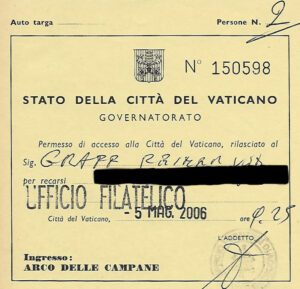
Customers located in Italy, or even in Rome, could go to the UFN issuing office and pick up the coin sets by themselves. However, that was only possible during the opening hours and after registering either at the office located at the entry St Ufficio or at the bell gate. There, you were given an entry ticket to the UFN that enabled you to pass the guards. At the UFN, the time you got there was precisely written down. Then, you had to get back to the office in order to sign out. You see, the process was extremely organised and long queues were nowhere to be found – not even in the Vatican Gardens.
Everything That Appeared to Come From the Vatican Was Sold
Yes, that’s an accurate description of the situation of those days. Even the flyers in which the UFN announced the issuing of euro coin sets were sold at up to €10! There were German dealers offering Vatican coin sets of 2002 for a lot of money even though the sets did not contain anything but Italian coins. The explanation – “In the Vatican, most things are paid for with Italian coins” – wasn’t very convincing. Other German dealers declared themselves as official distributors of the UFN and thus of Vatican coins in Germany. It wasn’t anything but a scam. There was even a dynamic market for the forms one had to fill in in order to obtain a coin set and stamps from the UFN.
But that is by no means the end of the story: empty coin set card folders were on offer, too – and, oddly enough, people bought them. Only later it became clear where these empty folders had come from: by selling the coins individually one could simply make more money. The same was valid for a “loose” coin set of 2002 and a normal plastic bag. With these ingredients, it is still possible to make an “original” starter kit by yourself. Moreover, there is still a demand for empty card folders. In a nutshell: all sorts of things were on offer, and that didn’t make the coins decrease in value – quite the opposite, prices increased even more.
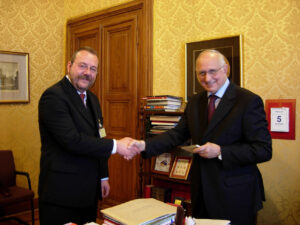
There are still coin dealers who claim that the loose Vatican coins they offer were delivered in rolls. However, there is proof that that’s not true. The mint in Rome delivers the coins either in card folders or in small plastic bags. Since the euro has been introduced, there have been no rolls of coins. However, legends stick for a very long time…
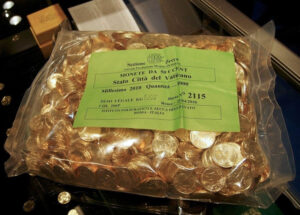
The Prices of Coin Sets Decreased Significantly
We could keep it short here and simply say, “Whoever purchased the first euro coin issues of the Vatican on the secondary market had bad luck.” Today, many coin sets of the first years are on sale for less than half price! The euro coin set (BU) of 2002 is probably the best example in order to illustrate this. In 2003, the set was sold at the price of €1,198. Today (15 December 2019), the same set can be bought for €249. Regarding the coin set of 2002 in proof quality, things aren’t different: what was once sold for €1,800 could be bought at the price of €550 on 15 December 2019. Therefore, there is a loss of €949 (BU) and €1,250 (PR) respectively. The prices of both sets from 2003 also plummeted. The following table illustrates the development. I used the Vatican coin sets (BU and PR) of the years from 2002 to 2006 because those are the sets whose prices have increased most. The impressive change in price should give everyone food for thought, after all we’re talking about a face value of €3.88!
Prices of Vatican Euro Coin Sets 2002–2006
| Year | Price 2003 BU | Price 2010 BU | Price 2019 BU | Price 2003 PR | Price 2010 PR | Price 2019 PR |
| 2002 | €1,198 | €590 | €249 | €1,800 | €1,050 | €550 |
| 2003 | €700 | €250 | €119 | €1,100 | €400 | €219 |
| 2004 | €490 | €240 | €110 | €980 | €350 | €190 |
| 2005 | €420 | €240 | €80 | €760 | €330 | €120 |
| Sede vacante 2005 | €300 | €280 | €320 | X | X | X |
| 2006 | €270 | €220 | €60 | €650 | €310 | €95 |
Cautious Forecasts and Trends
Strictly speaking, the prices of PR coin sets are still artificially secured by the accompanying silver medal of 45 grams of 925 silver. The silver price is a reason why the price of such coin sets will probably not crash completely.
In contrast, I am not sure whether that will be the case regarding BU coin sets. I believe that especially the coin sets of the first years (2002–2006) will remain at the low level they currently reached and will only increase a little in value over the next years. Currently, collectors are eliminating the wheat from the chaff, they do no longer care about the formerly sought-after completeness of a coin set. They rather adhere to the principle of cherry-picking.
The price of the unique set issued during the sede vacante of 2005 will certainly remain stable, it might even increase a little. And you shouldn’t consider the coin sets of the papacy of Pope Benedict XVI to be a lost cause even if their prices aren’t doing so well right now. If these coins are missing in your collection, you should purchase them now at a reasonable price.
What struck me especially regarding e-auctions was the welcome fact that, nowadays, the offer also includes the packaging a Vatican coin set had been mailed in to the customers – provided that it still exists. A while ago, the individual mailings to customers were a postal feast for the eyes. For a long time, a lot of manual work was done at the UFN. The coin sets were packed by hand and stamps were put on the mailings. Often, interesting special stamps were used on these occasions. But those times are gone. Today’s motto is meter stamps instead of adhesive stamps. What a pity!
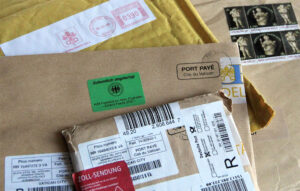
The first euro coins from the Vatican: that was a magic formula for many collectors even though nobody knew how prices would change over time. But what about the first 2 euro commemorative coins the Vatican issued from 2004 on in a card folder? How did the prices of the first numis covers change over time? You’ll find out more in part 2 of this series.
numiscontrol is our expert for deutsche mark, GDR mark, euro coins and zero euro banknotes. Here you can read his latest article about what the different European starter kits are worth today.
By the way, an updated version of the catalogue of euro coins minted between 1999 and 2019 was published recently (in German).
And in our Who’s Who you can find out more about numiscontrol.



